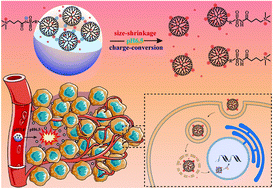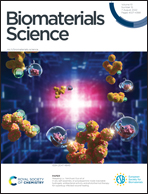Synergistic size and charge conversions of functionalized PAMAM dendrimers under the acidic tumor microenvironment†
Abstract
Developing nanomedicine with highly adaptive behaviors has shown great effectiveness in cancer treatment. However, the multi-functional integration of nano-therapeutic systems inevitably leads to complexity in the structure and impairs the operational efficiency or performance. Herein, we describe a novel nano-therapeutic system, G4-AB, capable of simultaneous dual conversions of the size and charge while targeting the acidic tumor microenvironment. G4-AB, containing a hydrophobic inner cavity for doxorubicin (DOX) loading, was synthesized by modifying amine-terminated 4th-generation polyamidoamine (G4-PAMAM) dendrimers with acylsulfonamide betaine (AB). Due to the dipole–dipole interaction among the AB moieties, G4-AB self-assembles to form micellar clusters with a zwitterionic surface. Possessing an anti-fouling property and suitable size, G4-AB exhibits optimized blood circulation under physiological pH conditions. Moreover, the extracellular pH value of the tumor microenvironment (pH 6.5) can trigger the protonation of acylsulfonamide, resulting in the cationization of AB and dissociation of G4-AB into unimolecular micelles (∼12 nm) due to electrostatic repulsion. The synergistic dual conversions further ensure drug accumulation with enhanced tumor penetration and cell internalization. The in vitro and in vivo experiments demonstrate that the G4-AB-DOX nano-therapeutic system possesses better antitumor efficiency and lower toxicity than free DOX or PEGylated PAMAM.



 Please wait while we load your content...
Please wait while we load your content...